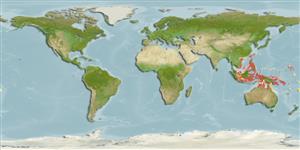Environment: milieu / Klimaatzone / Diepte / distribution range
Ecologie
marien; zoet water; brak water pelagic-neritic; amfidroom (Ref. 51243). Tropical; 27°N - 21°S
Western Pacific: Ryukyu Islands to New Caledonia.
Grootte / Gewicht / Leeftijd
Maturiteit: Lm ? range ? - ? cm
Max length : 23.0 cm SL mannelijk / geslacht onbekend; (Ref. 7050)
Dorsale stekels (totaal) : 11 - 12; Dorsale zachte stralen (totaal) : 10 - 11; Anale stekels: 3; Anale zachte stralen: 8 - 9.
Body shape (shape guide): fusiform / normal.
Adults inhabit salt and brackish waters of bays and estuaries, penetrating into fresh water (Ref. 1601). Juveniles are sometimes found in streams within 5-10 km of the sea (Ref. 2847). Eggs are guarded and fanned by the male parent (Ref. 205).
Levenscyclus en paargedrag
Maturiteit | Voortplanting | Paaien | Eieren | Fecunditeit | Larven
Eggs are guarded and fanned by the male parent (Ref. 205).
Masuda, H., K. Amaoka, C. Araga, T. Uyeno and T. Yoshino, 1984. The fishes of the Japanese Archipelago. Vol. 1. Tokai University Press, Tokyo, Japan. 437 p. (text). (Ref. 559)
Status op de Rode Lijst van het IUCN (Ref. 130435: Version 2025-1)
Gevaar voor de mens
Harmless
Gebruik door de mens
Visserij: van minder commercieel belang; Aquacultuur: mogelijk toekomstig gebruik
Tools
Speciale rapporten
Download XML
Internetbronnen
Estimates based on models
Preferred temperature (Ref.
123201): 26.6 - 29.2, mean 28.7 °C (based on 1282 cells).
Fylogenetische diversiteitsindex (Ref.
82804): PD
50 = 0.5312 [Uniqueness, from 0.5 = low to 2.0 = high].
Bayesian length-weight: a=0.01288 (0.00590 - 0.02812), b=3.04 (2.86 - 3.22), in cm total length, based on LWR estimates for this (Sub)family-body shape (Ref.
93245).
Trofisch niveau (Ref.
69278): 3.0 ±0.37 se; based on food items.
Weerstandsvermogen (Ref.
120179): Hoog, minimale populatieverdubbelingstijd minder dan 15 maanden (Preliminary K or Fecundity.).
Fishing Vulnerability (Ref.
59153): Low vulnerability (18 of 100).
🛈
